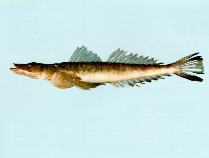| Family: |
Platycephalidae (Flatheads) |
| Max. size: |
45 cm TL (male/unsexed) |
| Environment: |
reef-associated; marine; depth range 10 - 50 m, non-migratory |
| Distribution: |
Western Central Pacific: Philippines, Borneo, Singapore, Papua New Guinea, the Arafura Sea (Ref. 9819) and Western Australia to Darwin and Brisbane, Australia. |
| Diagnosis: |
Dorsal spines (total): 9-9; Dorsal soft rays (total): 12-12; Anal spines: 0-0; Anal soft rays: 12-12. No pit present behind upper eye. Preopercular spines short, usually 2 subequal. Infraorbital ridge usually smooth over eye. Suborbital ridge bearing 1slight spine just behind eye, spine often obscure or lacking in adults. No dermal papillae on upper eye. Caudal fin with a large elongate dark blotch along upper and lower margins.
Description: Characterized by pale brown color with small dark brown spots; 0-2 anterior lateral-line scales bearing small weak spine; absence of preorbital spines; cirrose iris lappet (Ref. 90102). |
| Biology: |
Found in shallow coastal areas and reef flats to about 50 m. Usually captured by spear fishing or with ichthyocide, occasional specimen taken by trawling (Ref. 9790). |
| IUCN Red List Status: |
Least Concern (LC); Date assessed: 18 August 2023 Ref. (130435)
|
| Threat to humans: |
harmless |
Source and more info: www.fishbase.org. For personal, classroom, and other internal use only. Not for publication.
